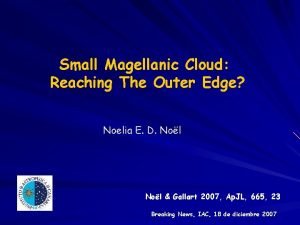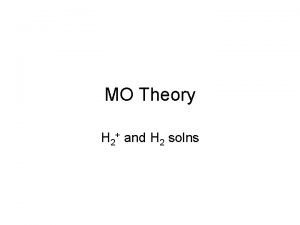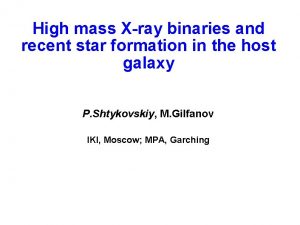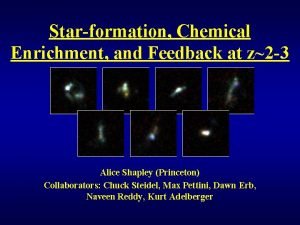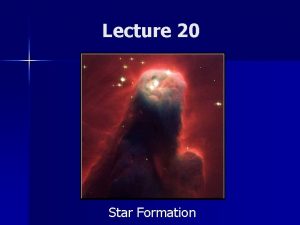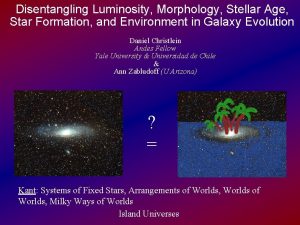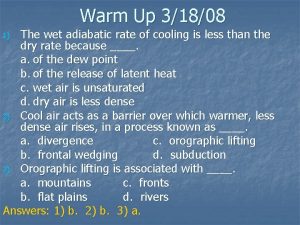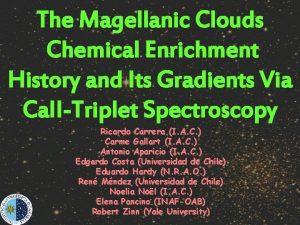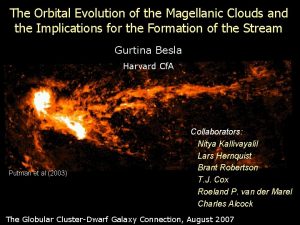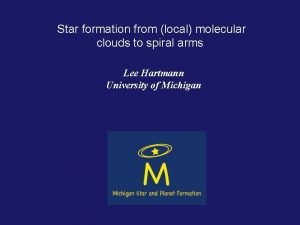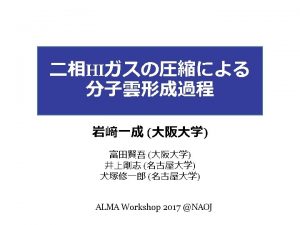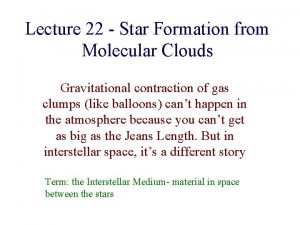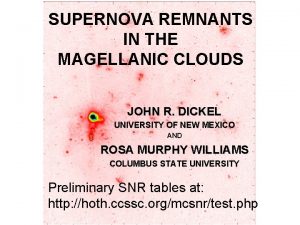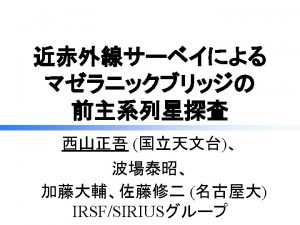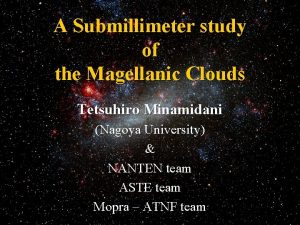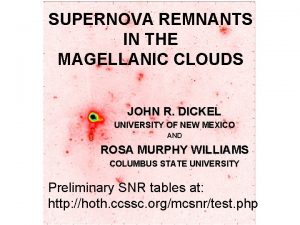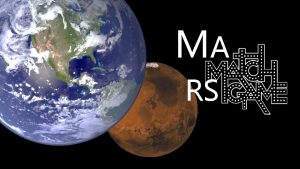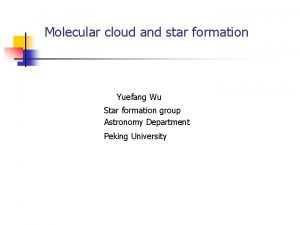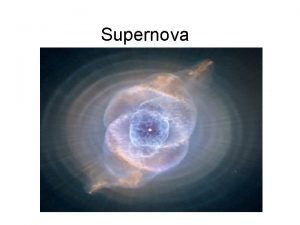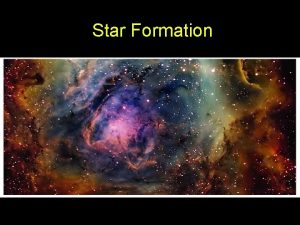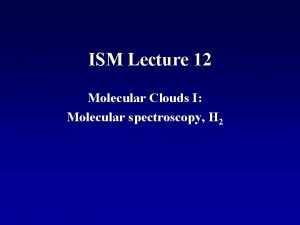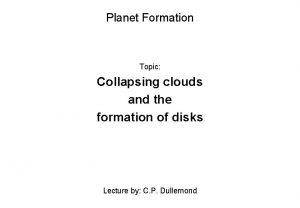Molecular Clouds and Star Formation in the Magellanic























































- Slides: 55

Molecular Clouds and Star Formation in the Magellanic Bridge and the SMC Yasuo Fukui, Norikazu Mizuno ( Nagoya University ) SMC Magellanic Bridge LMC Putman et al. 1998

Magellanic Bridge HI connection between the Clouds (LMC-SMC) M(HI) Bridge ~ 5. 5 x 107 Msun (Putman et al. 1998) Bridge was pulled from the SMC 0. 2 Gyr ago via a tidal encounter between the two Clouds, (e. g. , Murai & Fujimoto 1980, Gardiner, Sawa & Fujimoto 1994) Yong Stars in the bridge (6 -25 Myr) Blue stars and associations (e. g. , Irwin 1990, Grondin 1992, Hambly et al. 1994) Young star formation in the western region ( few Myr ) H filamentary shell (DEM 171, Meaburn 1986) Low Metallicity Z ~ 0. 08 Zsun Based on C, N, O, Mg, and Si (Rolleston et al. 1999) SMC metallicity Z ~ 0. 25 Zsun (e. g. , Russel and Dopita 1992)

Irwin et al. 1990

DEM 171, caused by a Wolf-Rayet star? Meaburn 1986

Magellanic Bridge Nearby (~ 58 kpc) and extremely low metallicity => understanding evolution of galaxies star formation in the early universe and distant galaxies big bang H・He small galaxies collision & merging Metallicity:low In this study, Star formation (molecular clouds) in the Bridge Future of the Bridge giant galaxies Metallicity =>high

Observation with NANTEN Diameter: 4 m Beam size 2. 6’ @115 GHz ~ 40 -50 pc@50 -60 kpc Velo. Res. 0. 1 km/s Band Width 100 km/s Tsys ~ 300 K (SSB) Integration time ~ 20 hours/point 2002 Oct. -2003 July Las Campanas Observatory

Search for CO in the Magellanic Bridge Toward a region of cold atomic hydrogen (Smoker et al. 2000) =>No CO and no stars Kobulnicky & Dickey 1999

Search for CO in the Magellanic Bridge Toward a HI peak with IRAS Source (Muller et al. 2003) The first detection of CO from the Bridge !

N(HI) > 1021 cm-2 Galactic latitude (degree) -45 -40 -35 -30 280 290 Galactic longitude (degree) 300 Putman et al. 1998

Clusters and Associations Bica & Schmitt 1995

Search for CO in the Magellanic Bridge with NANTEN HI (Muller er al. ) Targets HI and Dust peaks 16 regions 40 points IRAS 100μm

Results 8 CO clouds 1 -7 x 103 Msun HI M(H 2) ~2 x 104 Msun M(HI) ~5 x 107 Msun IRAS 100μm

TCO ~ 10 -60 m. K d. V ~ 1 - 4 km/s

SMC

Properties of Molecular clouds in the Bridge are similar to the clouds in the far outer Galaxy (Galactic Warp region) 35 (Nakagawa et al. 2005) 30 30 with IRAS sources 25 25 20 20 15 15 10 10 5 5 0 1 2 3 4 V(km/s) 5 6 2. 5 3 3. 5 Log(Mco) Molecular Clouds in the Bridge V~ 1. 5 km/s, Mcloud~ 5000 Msun 4 4. 5 5

Galactic Warp Nakagawa et al. (2005) 500 z(pc) 0 -500 -1000 -1500 Color: HI Red cross: CO 10 14 R(kpc) 16 18 20

Star Formation in the Bridge (Bica & Schmitt 1995) (Meaburn 1986) HI: Muller et al. 2003

Galaxy collision and formation of Tidal Dwarf Galaxy Braine et al. 2001 TDG: far(20 -135 Mpc), collision of disk galaxies, high metallicity Bridge: near(~ 60 kpc), collision of small irregulars, low metallicity

Magellanic Bridge evolve into a new dwarf galaxy? (Wiklind 2002 Nature) - Bica & Schmitt (1995) identified 3 clumps D 1, D 2, D 3. - similar to dwarf spheroidals (e. g, Fornax, Draco, Ursa Minor) - D 1 has two populous clusters (NGC 796, L 114) D 1 may evolve into a dwarf spheroidal (Bica & Schmitt 1995)

Star formation rate in the Magellanic Bridge Mass of CO clouds in the Bridge Mco ~ 1 -7× 103 Msun similar to Taurus molecular cloud SFR in Taurus molecular cloud N*~ 100, <m*> ~ 0. 7 Msun, τ ~106 yr, M~ 7 × 103 Msun =>1 × 10 -8 Msun, star/Msun, cloud /yr SFR estimate from molecular cloud mass SFR ~ 2 × 10 -4 Msun/yr SFR estimate from OB association in the Bridge ~ 100 OB association, M* ~ 100 Msun, τ~ 10 -25 Myr SFR ~ 6 × 10 -4 Msun/yr

Very Small Magellanic dwarf galaxy? Star formation is on-going and widespread SFR ~ 2 -6× 10 -4 Msun/yr, a few Gyr ~106 Msun Gravitationally stable system M(HI)~ 5× 107 Msun => d. V ~ 30 km/s d. VCO, HI ~ 20 -30 km/s Relation with LMC and SMC past collision interval 0. 2 -1. 5 Gyr (e. g. , Gardiner et al. 1994, Yoshizawa & Noguchi 2003) Mass ratio Mstar/M(HI) ~ 0. 02 ~ low-end for dwarf galaxies (Mateo 1998)

Summary • 8 CO clouds detected in the Magellanic Bridge - site of star formation - dust emission trace CO than HI - close to young associations - d. V~ 2 km/s, Mcloud ~ 1 -7 × 103 Msun To understand star formation process in the early universe ( low metallicity, HI rich, interacting system, dwarf galaxy ) • New small dwarf galaxy will be formed in the Bridge - collision of small galaxies also important in forming new galaxy - SFR~ 2 -6× 10 -4 Msun/yr, gravitationally bound Unique close-by laboratory to study galaxy formation with high resolution and high sensitivity

Small Magellanic Cloud (D ~ 60 kpc) ・Lower metallicity (Dufour 1984) SMC ~ 1/10 Zsun ・Higher gas to dust ratio (Koornneef 1984) 17 times higher than in our galaxy

Threshold for CO detection in galaxies Taylor et al. (1998) No CO detections

Observation with NANTEN • Diameter: 4 m • Beam size 2. 6 arcmin (@115 GHz) ~ 50 pc@60 kpc • Velo. Res. 0. 1 km/s • Band Width 100 km/s • Tsys ~ 300 K (SSB) • Total integration time ~ 1 hours 1998 Oct. -2003 July Las Campanas Observatory

Mizuno et al. 2001


27 CO clouds identified (10 clouds detected at one observed point. ) Mass: 6. 0× 104~ 9. 3× 105 Msun Radius: 35~80 pc Total molecular mass ~4. 5× 106 Msun ~ 0. 7 % of HI mass 6. 5 × 108 Msun (Hindman 1967)

Total molecular mass 5 × 106 Msun < 1% of the total atomic mass

NE region N(HI) ~ 6× 1021(cm-2) 14/20 show a single peak in HI SW region N(HI) ~ 9× 1021(cm-2) All observed points (51) show multiple peaks in HI

NANTEN & Spitzer Contour: NANTEN Image: Spitzer 3. 6(blue), 4. 5(green), and 8. 0(red) um Spitzer Imaging Survey of the SMC(S 3 MC) by Bolatto et al.

Properties of molecular clouds in the SMC n n Weakness of CO Less C and O abundances => slower CO formation Less dust => faster CO photodissociation No diffuse CO in the inter-cloud medium CO molecules can only survive in the dense region


Star formation in the SMC n Comparisons of the CO clouds with clusters, associations, and emission nebulae. n SW region --- small, but bright HII regions (e. g. , N 12, N 27) on-going formation of massive stars in large CO clouds NE region --- large evolved HII region (e. g. , N 66) smaller CO clouds Wing region --- small bright HII regions are associated CO clouds n n

H





Rubio et al. 2004 SIMBA 1. 2 mm CO(2 -1) CO emission arise from high column density clumps ?

(Lequeux et al 1994) In the Galaxy, CO appears at lower distance from the surface of the cloud

SMC Magellanic Bridge LMC Putman et al. 1998

Star formation orange:IRAS 100μm

Yoshizawa & Noguchi 2003

Yoshizawa & Noguchi 2003

Contour: IRAS 100μm Declination (J 2000) -74° -75° Contour: IRAS 100μm 2 h 20 m Right Ascension (J 2000) 2 h 0 m 1 h 40 m

3 4 2 1 Color : HI (Muller )

Spectra of the HI and CO in the Bridge 11 V : 1. 50 km/s 2 V: 0. 77 km/s - HI -CO 33 線幅: 0. 91 km/s 44 V : 2. 08 km/s



太陽質量 1012 (Mateo 1998) 1011 1010 109 108 107 M 31 銀河系 LMC M 33 SMC M 32 NGC NGC ブリッジ Fornax Ursa Draco Carina Sculptor 185 6822 147 Galaxy name Minor

Studies of the SMC n n understanding evolution of galaxies star formation in the early universe and distant galaxies

HI Stanimirovic et al. 1998


Bica et al. 1995
 Magellanic cloud
Magellanic cloud Star of wonder star of night star of royal beauty bright
Star of wonder star of night star of royal beauty bright Nimbus clouds
Nimbus clouds What is a covalent bond simple definition
What is a covalent bond simple definition Giant molecular structure vs simple molecular structure
Giant molecular structure vs simple molecular structure Zinc oxide + nitric acid → zinc nitrate + water
Zinc oxide + nitric acid → zinc nitrate + water A star and ao star algorithm
A star and ao star algorithm Formation of molecular orbitals
Formation of molecular orbitals What does star events stand for?
What does star events stand for? Star formation
Star formation Expcism
Expcism Cassandra lovejoy
Cassandra lovejoy Star formation
Star formation Formation initiale vs formation continue
Formation initiale vs formation continue Compare and contrast clouds and fogs.
Compare and contrast clouds and fogs. Hát kết hợp bộ gõ cơ thể
Hát kết hợp bộ gõ cơ thể Lp html
Lp html Bổ thể
Bổ thể Tỉ lệ cơ thể trẻ em
Tỉ lệ cơ thể trẻ em Chó sói
Chó sói Chụp tư thế worms-breton
Chụp tư thế worms-breton Chúa yêu trần thế alleluia
Chúa yêu trần thế alleluia Các môn thể thao bắt đầu bằng tiếng bóng
Các môn thể thao bắt đầu bằng tiếng bóng Thế nào là hệ số cao nhất
Thế nào là hệ số cao nhất Các châu lục và đại dương trên thế giới
Các châu lục và đại dương trên thế giới Cong thức tính động năng
Cong thức tính động năng Trời xanh đây là của chúng ta thể thơ
Trời xanh đây là của chúng ta thể thơ Mật thư anh em như thể tay chân
Mật thư anh em như thể tay chân Làm thế nào để 102-1=99
Làm thế nào để 102-1=99 Phản ứng thế ankan
Phản ứng thế ankan Các châu lục và đại dương trên thế giới
Các châu lục và đại dương trên thế giới Thể thơ truyền thống
Thể thơ truyền thống Quá trình desamine hóa có thể tạo ra
Quá trình desamine hóa có thể tạo ra Một số thể thơ truyền thống
Một số thể thơ truyền thống Cái miệng bé xinh thế chỉ nói điều hay thôi
Cái miệng bé xinh thế chỉ nói điều hay thôi Vẽ hình chiếu vuông góc của vật thể sau
Vẽ hình chiếu vuông góc của vật thể sau Nguyên nhân của sự mỏi cơ sinh 8
Nguyên nhân của sự mỏi cơ sinh 8 đặc điểm cơ thể của người tối cổ
đặc điểm cơ thể của người tối cổ Thế nào là giọng cùng tên
Thế nào là giọng cùng tên Vẽ hình chiếu đứng bằng cạnh của vật thể
Vẽ hình chiếu đứng bằng cạnh của vật thể Phối cảnh
Phối cảnh Thẻ vin
Thẻ vin đại từ thay thế
đại từ thay thế điện thế nghỉ
điện thế nghỉ Tư thế ngồi viết
Tư thế ngồi viết Diễn thế sinh thái là
Diễn thế sinh thái là Các loại đột biến cấu trúc nhiễm sắc thể
Các loại đột biến cấu trúc nhiễm sắc thể Bảng số nguyên tố lớn hơn 1000
Bảng số nguyên tố lớn hơn 1000 Tư thế ngồi viết
Tư thế ngồi viết Lời thề hippocrates
Lời thề hippocrates Thiếu nhi thế giới liên hoan
Thiếu nhi thế giới liên hoan ưu thế lai là gì
ưu thế lai là gì Sự nuôi và dạy con của hổ
Sự nuôi và dạy con của hổ Sự nuôi và dạy con của hươu
Sự nuôi và dạy con của hươu Hệ hô hấp
Hệ hô hấp Từ ngữ thể hiện lòng nhân hậu
Từ ngữ thể hiện lòng nhân hậu
